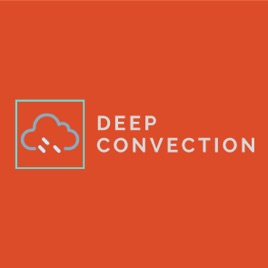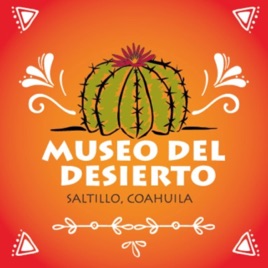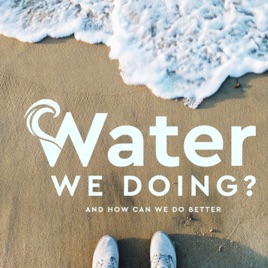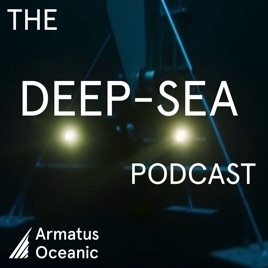
Advertise on podcast: Deep Convection
Rating
4.8 from
Country
This podcast has
47 episodes
Language
Publisher
Explicit
No
Date created
2020/02/23
Average duration
91 min.
Release period
16 days
Description
Deep Convection is a podcast featuring real conversations between climate scientists (or sometimes those working in areas adjacent to climate science). The goal is to capture what it is like to work in our field at this moment in history. We talk about our lives, how we came to do what we do, what the work means to us, and how that is changing, or isn’t – and sometimes about science. Our top priority is to capture good conversations, but if some learning happens that’s fine too.
Podcast episodes
Check latest episodes from Deep Convection podcast
Episode 10: Frank Marks
2024/01/15
Shortly after Hurricane Otis hit Mexico in late October 2023 after a very rapid (and poorly forecast) intensification, Adam sat down with Frank Marks from NOAA's Hurricane Research Division (HRD) for the last episode of this season. Frank is one of the central figures in the world of hurricane science. With a career spanning over four decades at the Hurricane Research Division (HRD) of the National Oceanic and Atmospheric Administration (NOAA), Frank has been instrumental in advancing our understanding of hurricanes and improving their forecasts.Frank's journey with HRD, including two decades as its director, has been dedicated to unraveling the inner workings of hurricanes, with the objective of improving their forecasts (which are not made by the HRD, but by the National Hurricane Center). This pursuit has led Frank to fly through the eyes of over 100 different storms, crossing the eye of a hurricane more than 500 times.
"Sitting at a desk and writing papers and doing analysis, that's also enjoyable, but there's nothing like getting out in the environment [...] I always try and encourage even my numerical modeling partners to come on a flight so they can see what it takes to get the information that they need , and almost all of them step away from that with a different perspective. […] There's nothing like breaking out into the eye and seeing mother nature in all her glory or just flying to the storm and seeing the halos from the rain falling down. The natural beauty is there, and the thing about a hurricane is, you go from the most wonderful weather into the worst thing you can imagine in a very short time, and out the other side, and you do that repeatedly."
However, reducing Frank's career to just these flights would be an understatement. He is a distinguished scientist with 139 published papers to his name and a mentor who has guided many junior scientists. His contributions to the field have earned him numerous accolades, reflecting his deep and broad contribution to hurricane science.
One of Frank's most notable achievements has been the development and application of airborne Doppler radar technology. This innovation has allowed for an unprecedented view of hurricane structures, playing a crucial role in improving hurricane intensity forecasts through the Hurricane Forecast Improvement Project, which Frank conceived and led. This project represents a significant national effort to tackle the challenge of predicting hurricane intensity more accurately, a crucial factor in safeguarding lives and property.
Frank’s conversation with Adam traces his path from his early interest in meteorology as a high schooler in New York's Hudson Valley, through his graduate studies at MIT, and on to his long-standing tenure at NOAA since 1980. Frank's story is not just about the science; it's also about the institutions, the art of scientific communication, and his approach to addressing some of the more outlandish ideas about hurricane intervention (like using nuclear weapons).
Throughout the discussion, Frank’s humility shines through. He continually acknowledges the contributions of his mentors, colleagues, and team members, emphasizing the collaborative nature of scientific progress. He attributes his success to not only his own efforts but also to being at the right place at the right time and seizing the opportunities presented to him.
The interview with Frank Marks was recorded in October 2023. Image credit: NOAA
Frank's website at NOAA/HRD
more
Episode 9: Bjorn Stevens
2023/12/18
Bjorn Stevens’ main scientific interest is in the role of clouds in the climate system. He established himself early in his career as a leader in the study of marine stratus-topped boundary layers. That eventually led him to a broader climate research agenda. And since about 2008, Bjorn heads one of the world’s most prominent climate modeling labs, the Max Planck Institute for Meteorology in Hamburg. In that position, with his team there and many collaborators, he has produced an enormous volume of important research, and that’s not to mention the countless additional studies that use the data his lab contributes to the CMIP archives.Bjorn’s personal story is as fascinating as his professional achievements. Born in Germany, he first moved to the US when he was only a few months old, and from then on he and his family kept moving a lot for his father’s work. Because of that, his education ended up being “a bit of a patchwork”, but he soon realized that he felt drawn to the beauty of math and science:
“Science opened itself up as something that I seemed reasonably good at, and I felt the rewards of doing it. It had this wonderful mix of being creative work, and it had an aesthetic to it. It involved many different skills from writing to analyzing to programming, so it was just something I [...] realized and enjoyed, and I had a certain amount of success that allowed me to continue.”
Bjorn did indeed continue, from his PhD at Colorado State and early career at NCAR and UCLA, to his current position as managing director of the Max Planck Institute for Meteorology in Hamburg. His research covers many topics, but a particular focus have been clouds—he has studied them as a modeler and as a theorist, and he has led many field campaigns to collect data that improve our understanding of these elusive yet critical components of the climate system.
“How does precipitation affect the clouds? There were some simple hypotheses at the time […] which didn't make sense to me, and so I tried to understand how drizzle affects the development of the cloud layer. So that was mostly my PhD thesis, and at that time I was really concerned with how to use models to come up with ideas that we could test in observations. So I think that's also an enduring aspect of the way I think about things, which is not to use models to provide answers but to use models to tell us how to look at nature differently.”
Bjorn’s leadership role in the global climate science community goes well beyond his astonishing scientific productivity. He has a unique gift for starting, leading and facilitating important and sometimes difficult scientific conversations.And currently, Bjorn is doing this in a bigger way than ever before, as he leads an international effort to develop the Earth Virtualization Engine, or EVE. EVE is conceived as a large international collaboration, taking CERN—the particle physics facility—as a model. EVE’s proposed mission is to develop kilometer-scale, that is, ultra high-resolution global climate models, using the biggest computers that exist, and use them to support climate services worldwide. You’ll hear Adam and Bjorn spend quite a bit of time talking about that towards the end of their conversation.
The interview with Bjorn Stevens was recorded in September 2023. Image credit: MPI-M, D. Ausserhofer
Bjorn's website at Max-Planck-Institut
more
Ask Adam Anything
2023/12/05
Adam answers listener questions!
About Deep Convection
2023/11/21
In this episode we take a break from guest interviews. Instead, Adam explains in detail how the podcast got started, how and why we do it, and who is involved. Just like when you go to any web site or anything and there's an "About" link, this is that, except via 40 minutes of talking.
more
Episode 8: Arlene Fiore
2023/11/06
Arlene Fiore got interested in air pollution first as a kid in the Boston suburbs, partly because she suffered from bad asthma, and that taught her that the air can be harmful. Even though her interest in the Earth’s atmosphere was there from an early age on, the path that led her to her current position as a professor in MIT’s Department of Earth, Atmospheric and Planetary Sciences was, in her own words, a circuitous one, partly because of life's inherent unpredictability and coincidences, but also because of Arlene's wide array of interests. When it came to thinking about what to do in college, she struggled to make a decision:
"And then when I was thinking about college I really didn't know what I wanted to do. I mean, I really had broad interests—I liked history, I liked math and science, I liked English. […] The things that I started thinking about though were really probably more geared towards engineering, and that was because my dad was an engineer.
I was [also] pretty serious about track and cross country running, [and so] I was trying to find places where I could run and do all these things. In the end I applied to a bunch of places, and my mom had really wanted to see if I could get into Harvard, and so I applied there and I vividly remember telling her she was wasting her $50 application fee because there was no way."
Those $50, as history would have it, became a pivotal investment in Arlene's life—she got into Harvard, where it was eventually the earth and planetary science courses that captivated her, and where she soon started to do research in atmospheric chemistry in Daniel Jacob’s group.
She ended up staying at Harvard for a PhD, a decision that had taken some nudging by those around her, who saw Arlene’s potential more clearly than she saw it herself.
Arlene has become an expert in atmospheric chemistry, air pollution, atmospheric transport, and climate. She uses numerical models to understand all the different factors that influence the concentration of constituents that affect human health, especially ozone. Her early work was about defining the “background” ozone that sets the floor for air quality regulations, and especially understanding the role of long-range transport of ozone itself as well as its precursors. Her work has uncovered linkages between air quality and climate change, for example by highlighting the role of methane, a greenhouse gas, in regulating ground level ozone. And she’s made important contributions on a range of other topics, including not just chemistry but, more lately, physical climate, including extreme events.
From the beginning Arlene’s research has had direct implications for policy. Translating between the abstract world of atmospheric chemistry and the concrete realities of policy and regulation, Arlene has been working with a range of stakeholders to influence regulation and practice at the federal, state and local levels.
Yet she does this stakeholder-engaged policy work while remaining a highly productive basic researcher whose work contributes to fundamental understanding. Listening to Arlene, you’ll notice that she has a rare combination of personal talent and a profound commitment to collective scientific progress, and an ability to shine while ensuring others do too.
The interview with Arlene Fiore was recorded in September 2023. Image credit: Steph Stevens
website of Arlene's group at MIT
more
Episode 7: Aglaé Jézéquel
2023/10/23
Aglaé Jézéquel's journey began surrounded by books, in a home where knowledge was cherished. Aglaé shared her parents’ passion from an early age on, but while her family was more into literature, she fell in love with science. Her academic path has led her to her current position as a scientist at the Laboratoire de Météorologie Dynamique at the École Normale Supérieure in Paris, where she does research spanning climate science and social science. She is not a climate scientist whose work extends into social science, or a social scientist who collaborates with climate scientist—no, she’s genuinely a physical climate scientist and a social scientist at the same time. Her PhD thesis had roughly equal components of both, and she writes legitimate research papers in both.
It’s not just methodological, though. When Aglaé talks, her scientific curiosity comes across as inextricable from her desire to do something about the climate problem, and as part of that, to understand both the earth system and the human, social processes involved. She has made multiple substantive contributions to the methodology, both its statistical aspects, and meteorological questions like how to characterize the atmospheric circulation of events in a way that makes attribution more effective.
Aglaé has worked a lot on extreme event attribution, that is, the science of relating individual extreme weather events to climate change. She has made multiple substantive contributions to the methodology, both its statistical aspects, and meteorological questions like how to characterize the atmospheric circulation of events in a way that makes attribution more effective.
But she has also studied how attribution science is used by those outside the scientific community, and in the space between the physical and social science dimensions, Aglaé has contributed in major ways to the discussion about the relationship between the two major types of attribution, "storyline" and "risk" approaches.
For many in the climate science field, there's a palpable tension between pure scientific curiosity and the aspiration to effect real-world change. Thanks to her natural ability to integrate these two spheres, this tension seems to be much less present for Aglaé—and probably also for many young scientists of her and future generations.
"One thing I've realized is that you have two different motivations as a scientist […], one is curiosity and the other one is social usefulness, and they generally don't really align. And you have to be okay with that. They can align to a point but they don’t entirely, and I think it's important to be aware of that. And then [...] I try to think not only as myself, but as what does a society wants from scientists and why are we paid by the state to do science. […] I [try to be] relevant as a scientist for society."
The interview with Aglaé Jézéquel was recorded in August 2023.
Aglaé's website at ENS
more
Episode 6: Sarah Kapnick
2023/10/09
Sarah Kapnick's journey in the climate world has not been a conventional one. Starting as a "math nerd in the Midwest", her path meandered through investment banking, back to academia for a PhD., and now to one of the most influential positions in US climate science and policy - Chief Scientist of the National Oceanic and Atmospheric Administration (NOAA).
Sarah's initial foray into the world of finance might seem unorthodox for a climate scientist, but in reality, it was a preview of the broader understanding she would bring to the field. At Goldman Sachs, she learned how to structure catastrophe bonds, a financial instrument intrinsically linked to climate-related events such as hurricanes. Sarah realized that accurately quantifying the risk of such events requires an understanding of how their probabilities of occurring in the present-day climate may differ from their historically observed occurrence probabilities. So, she decided to go back to academia and become an expert in this field.
She first went to UCLA to do a PhD and then on to NOAA's Geophysical Fluid Dynamics Laboratory in Princeton. Here, Sarah was at the forefront of developing climate models, forecasting climate patterns from mere months to many decades into the future. At the same time, she kept doing some research at the intersection of climate and economics. After her decade-long stint at GFDL she went back to another bank, before getting recruited to be NOAA Chief Scientist.
What distinguishes Sarah beyond her scientific credentials is her ability to bridge disparate worlds, and to merge science, finance, and leadership. Her return to NOAA as Chief Scientist comes at a pivotal moment. With climate changes already upon us, the need for informed, integrated action has never been more pressing – and Sarah is a great person to drive the transition from identifying climate problems to actively developing solutions. She emphasizes the interdependence of user-driven and basic science in making that transition happen:
"We still need our basic research, but we also need to transform, because if we are going to deal with the manifestations of climate change, which are going to continue happening and continue to get worse and continue to evolve in the coming years and decades until emissions reach zero, we need to prepare and know what to do. And so the science needs to continue, needs to be fundamental because that drives the [creation of] models that can actually do things that are actionable."
The interviews with Sarah Kapnick were recorded in March 2023. Image credit: NOAA/GFDL
Sarah's website at NOAA
more
Episode 5: Tapio Schneider
2023/09/25
Growing up outside Braunschweig, just on the west side of the border with East Germany during the Cold War, Tapio Schneider spent a lot of his teenage years doing sports, and skiing (often just meters away from the East German border patrol) became a large part of his life.
He also had a keen interest in science and a desire to understand the world around him, and so he decided to study physics and math---he did that at the University of Freiburg, a school he picked in no small part due to its close proximity to the Black Forest, which meant that he could continue to ski as much as possible.
Science became more and more important to him though, and after he came to the US (with what was supposed to be an exchange fellowship, but Tapio ended up not going back to Germany), his career quickly took off, starting from his PhD with Isaac Held (a previous guest on the podcast) at Princeton and on to his current position at Caltech. The array of topics on which Tapio has made major contributions, and the magnitude and impact of those contributions are astonishing. After his early, field-changing work on the general circulation of the atmosphere, Tapio did a whole set of studies on planetary atmospheres. And then he got into marine stratocumulus, and the parameterization of those clouds in models. This led him to studies of clouds and climate more broadly, and eventually to rethinking how climate models should work from the ground up. On top of that, Tapio's early work on statistical methods, though just an aside for him, have become hugely influential papers for statisticians and scientists alike.
For the last few years, Tapio has been leading the CliMA project at Caltech. A visionary endeavor, the project aims to bring about a paradigm shift in the way climate models are constructed and used. It advocates for a more holistic approach, making use of observations, machine learning, and high-resolution simulations. The inception of CliMA came from a series of workshops on the future of Earth system modeling.
They ended up being a lot of fun and very interesting. […] Each time, it was like 30-some people, perhaps. So it was fairly small, [and] you could interact intensely with everyone. And we we were just trying to ask the question, "So suppose you don't have to deal with these layers upon layers of history on climate models, how would you go about building a climate model now if you could?" And it was really meant as a hypothetical at the time. There wasn't any plan to build a climate model.
The plan came later, and it turned into CliMA. As with any pioneering venture, the road hasn’t always been easy, but Tapio has an exceptional ability to treat challenges just as problems to be solved step-by-step—and to not lose sight of the big picture while doing so.
The interview with Tapio was recorded in December 2022.
Tapio's website at Caltech
Website of the Climate Modeling Alliance (CliMA)
more
Episode 4: Abhisheik Dhawan
2023/09/11
In keeping with this season’s excursions away from Deep Convection’s traditional focus on climate science, this episode features Abhisheik Dhawan. While he's not a climate scientist, his innovative ideas intersect with climate change, development, and finance in a unique way. He is currently a Sustainable Finance and Partnerships Specialist at the United Nations Capital Development Fund (UNCDF), an organization that focuses on providing essential financial support to the world’s least developed countries.
In that role, Abhisheik is responsible for coming up with innovative mechanisms for providing sustainable finance to the world’s poorest countries. And the mechanism he has come up with is called Climate Insurance Linked Resilient Infrastructure Finance, or CILRIF.
The premise of CILRIF is to grant long-term insurance to cities against weather and climate related calamities, such as floods and storms. Then, when cities actively invest in resilience or adaptation methods, they receive a cut in the premium. So CILRIF’s ultimate aim is to assign a tangible price tag to climate adaptation in urban settings, thus unlocking capital for it.
While it might sound fairly straightforward, this is in some ways quite a radical proposal. For instance, the long-term contracts it proposes are nearly unheard of in the world of property insurance. CILRIF is not operational yet, but for nearly three years, Abhisheik has been at the helm of a volunteer working group, collaborating with insurers, academics, engineers, and finance experts to set the CILRIF wheels in motion.
"[What we want] is resilient cities, whatever that means for that city. [...] You need to define for every city on the planet, […] what is the extreme climate it is most exposed to? We don't want to look at financing for regular floods […] which have been happening every year […]. But looking at a 200-year flood […], which will have a devastating effect on a community, how do you protect from that? And actually if you protect from that, then you will automatically reduce the damage from regular floods as well."
Of course, Adam also talks with Abhisheik about his whole life and career, starting with his origins in Lucknow/India, his training and early employment as a mining engineer, how he transitioned to finance and then made it to the US, to do a graduate degree at Columbia, and then into his current role.
The interview with Abhisheik was recorded in March 2023.
Abhisheik's website at the UNCD
more
Episode 3: Bob Kopp
2023/08/28
Bob Kopp’s academic roots lie in the realms of paleoclimate, paleobiology, and ecology. But, inspired by a legacy of public service passed down from his parents, he soon gravitated towards areas where science meets actionable change. Over the course of his career, he has learned to master the dance of blending use-inspired, policy-oriented research with traditional academia.
Today, Bob is a professor in the Department of Earth & Planetary Sciences at Rutgers University, but that role is just one of many hats he wears: He is also Co-Director of the University Office of Climate Action, and he directs the Megalopolitan Coastal Transformation Hub. And as if that weren't enough, he is also a driving force behind the Climate Impacts Lab. This consortium has pioneered an integrated assessment model, which now influences the EPA's estimates of the social cost of carbon—an important metric for assessing climate impacts of federal policies.
As Adam and Bob delve into their conversation, they traverse the challenges and rewards of Bob’s diverse career—from his enriching interdisciplinary postdoc to the Department of Energy, and even to the challenges of today’s climate policy in the US. They touch upon the setbacks, like the Waxman-Markey act's failure, as well as on milestones such as the Inflation Reduction Act.
They also talk about the difficulty and obstacles in doing policy-oriented research while remaining viable as an academic (something that Bob has managed to do to a remarkable degree), and about the importance and undervaluation of boundary workers:
"In this case, the boundary is between researchers who have the science, and policymakers or community members who have decisions they're trying to make, […] like how high we should require houses to be built. You can look at [this problem] from the perspective of the municipal government, or you can look at it from the perspective of sea level scientists. But [...] you need people in the middle who [...] are fluent talking to scientists and who are fluent talking to non-scientists. And who are helping helping the two of them have discussions that can inform the decisions and shape the science that is done."
The interview with Bob was recorded in December 2022. Image credit: Rutgers University
Bob's website at Rutgers University, and his personal website
more
Episode 2: Hannah Reyes Morales
2023/08/14
In the second episode of this season, we're branching out from the traditional, science-centered sphere of Deep Convection and into a world captured through the lens of Manila-born photojournalist, Hannah Reyes Morales. Hannah and Adam crossed paths a dinner at the Columbia Institute for Ideas and Imagination in Paris, where they found themselves immersed in a discussion sparked by shared interests: the relentless typhoons that shape life in the Philippines.
From a young age, Hannah was enchanted by the vibrant pages of National Geographic magazines at her home in Manila. A career as a photographer for such an esteemed publication seemed as far-fetched to her as becoming an astronaut, yet this dream became her reality. Her journey is a blend of happenstance, grit, and an immense passion for her craft, leading her to places and stories all over the world.
"When I was a kid I lived in a very cloistered environment. Manila in the 90s was not—I mean it's arguably still not the safest place, but Manila in the 90s was a little more crazy. And so I wasn't really allowed to play outside. [...] I spent a lot of my time indoors and photography for me was one of the ways where I really felt like I could explore and, you know, tickle my imagination—all those worlds that seemed so far away and yet so near through a photograph. That was something that I truly fell in love with."
Hannah's work documents the resilience of struggling communities across Asia, often focusing on the personal narratives unfolding under the impact of inequality, poverty, and injustice. One story that gets highlighted here is about women in the Philippines propelled into the sex trade by the losses suffered during Typhoon Haiyan.
Hannah also talks about Emerging Islands, a unique initiative she co-founded to facilitate collaborations between artists and scientists, focusing on the thematic intersections of oceans, nature, and climate. Finally, she and Adam have a profound discussion about their shared experiences as researchers and storytellers. They question the purpose and impact of their work, particularly when they confront misinformation or indifference.
The interview with Hannah was recorded in November 2022.
Hannah's website featuring examples of her photos and stories.
more
Episode 1: Rebecca Morss
2023/08/01
Rebecca Morss' scientific credentials are impeccable – a PhD in atmospheric science from MIT, more than 20 years of experience at the Mesoscale and Microscale Meteorology (MMM) Laboratory at the National Center for Atmospheric Research (NCAR), and currently the Senior Scientist and Deputy Director of the center. But what really sets Rebecca apart is her focus on the intersection between scientific information and its use by people.Rebecca is an expert in weather forecasting systems and risk communication, and she specializes in high-impact weather including hurricanes, floods, and tornadoes. Her research isn’t limited to the intricacies of weather phenomena and prediction, but extends to how forecasts are formulated, communicated, received, and acted upon. For Rebecca, science is not a solitary endeavor but a bridge that connects researchers, societal stakeholders, and policy-makers alike.Despite the importance of weather predictions in preserving lives and property, ensuring that people understand these forecasts and know how to act upon them has often been overlooked and underfunded. In her conversation with Adam, Rebecca talks about how she has retained her unique identity as a physical scientist while navigating the challenges of this inherently interdisciplinary sphere:"There's a lot of counterincentives. I've been to workshops on interdisciplinary research [...] in a variety of fields, and if you talk to professors at universities, even if they wanna do this, there's so many barriers to doing it, there's so many disincentives. The best way to get ahead if you're in a research career is to publish a lot of papers and get a lot of citations. And the best way to do that is to do something that other people are doing, and to not buck the trend. It takes a lot longer to learn new things every time. People aren't citing you if no one else is doing it."Adam's and Rebecca's discussion then pivots to two recent extreme weather events. First, Hurricane Ian, where an evacuation order delay resulted in tragic loss of life in Lee County/Florida. Second, the Marshall Fire of December 2021, a disaster that literally hit close to home for Rebecca. The fire ravaged her neighborhood in Boulder County, Colorado, coming perilously close to her own house, and giving her a first-hand experience of the crucial role of effective risk communication.The interview with Rebecca was recorded in October 2022.Rebecca's website at NCAR
more
Podcast reviews
Read Deep Convection podcast reviews
Ray Najjar
2022/04/21
Ray Najjar
I have been devouring these podcasts since I learned of them about a month ago. I’ve been going through the archives, starting with some of the older ...
more
Pixel89
2021/04/28
Excellent interviews
An interesting set of interviews that beautifully present the broad diversity of pathways into science, lives, and thought patterns of climate scienti...
more
Plantsperson
2020/05/29
Fun, in-depth conversations
Interesting scientists, real conversations about key moments in their careers, some “aha” moments about climate and how science works.
T to the tizzy
2020/05/18
Oral history of scientists
While the overt audience would appear to be professional academic scientists primarily in the area of Earth, atmospheric, and climate science; it can ...
more
Nancy Vitameatavegamin
2020/04/15
Eavesdrop on great climate scientists talking
This is a really terrific podcast that offers something unique, chance to listen in on wide-ranging conversations between scientists—climate scientist...
more
SmashHit-o-holic
2020/04/12
Excellent discussion & a suggestion
Great discussion...occurs to me that ecologists tend to have more a the sense of the sacredness of landscape and often work with indigenous groups to ...
more
1128tennis
2020/03/28
Great podcast!
Informative! Intelligent! And very interesting. Up to date about the Coronavirus.
Podcast sponsorship advertising
Start advertising on Deep Convection & sponsor relevant audience podcasts
You may also like these earth sciences Podcasts

0
0
201
Museo Del Desierto
Museo Del Desierto

4.7
107
328
Paranormal Odyssey
Paranormal World Productions

5
21
23
How We Got Here
Stephanie Spera and Rachel Lupien

4.7
37
1087
American Shoreline Podcast Network
The American Shoreline Podcast Network

0
0
31
Brújula Sonora Podcast
Transforma

4.7
153
226
Palaeocast
Palaeocast

5
5
25
مد وجزر | Mad wa Jazr
Sowt | صوت

0
0
44
Water We Doing?
David Evans

4.9
34
88
The Deep-Sea Podcast
Armatus Oceanic

4.5
35
77
AcresUSA: Tractor Time
Tractor Time by Acres U.S.A.



